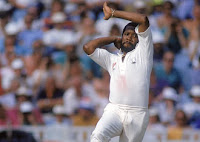Firstly, its important to understand that all deliveries lose pace after ball release from the hand and contact with the wicket.
You may often hear comments like ‘he’s quick off the wicket’ or ‘he seems to pick up pace off the wicket’.
These comments can be misleading, perhaps a bowler has a strong action and the ball has greater speed than a batter anticipates or a spin bowler bowls a ball with a lot of top spin and the ball spins forward more than it does sideways.
But all deliveries will lose velocity as the ball moves forward.
Anyway, back to your question, how to make sure that your bouncer keeps as much speed as possible.
You need to examine the length you are bowling.
If you are banging the ball in too short then the ball will lose a lot of pace and it will balloon through to the wicket keeper or batsman, rather than holding its pace and trajectory.
Practice varying your lengths to see if you can bowl the bouncer with a slightly flatter trajectory, about head high or up into the batter’s rib cage.
This will keep greater speed on the ball.
Also work on making sure that your action is vigorous and that you work hard all the way through your follow through.
See the picture of Dale Steyn above, as an example and notice the full follow through which is the completion of the delivery.
Quite often what a bowler thinks is a bouncer is really a half tracker, bowled half way down the wicket with little intent on the ball.
Make sure that each ball has a goal, in height, direction and speed. Where you want the batter to move to or to hit the ball with the intention of forcing a catch.
You may often hear comments like ‘he’s quick off the wicket’ or ‘he seems to pick up pace off the wicket’.
These comments can be misleading, perhaps a bowler has a strong action and the ball has greater speed than a batter anticipates or a spin bowler bowls a ball with a lot of top spin and the ball spins forward more than it does sideways.
But all deliveries will lose velocity as the ball moves forward.
Anyway, back to your question, how to make sure that your bouncer keeps as much speed as possible.
You need to examine the length you are bowling.
If you are banging the ball in too short then the ball will lose a lot of pace and it will balloon through to the wicket keeper or batsman, rather than holding its pace and trajectory.
Practice varying your lengths to see if you can bowl the bouncer with a slightly flatter trajectory, about head high or up into the batter’s rib cage.
This will keep greater speed on the ball.
Also work on making sure that your action is vigorous and that you work hard all the way through your follow through.
See the picture of Dale Steyn above, as an example and notice the full follow through which is the completion of the delivery.
Quite often what a bowler thinks is a bouncer is really a half tracker, bowled half way down the wicket with little intent on the ball.
Make sure that each ball has a goal, in height, direction and speed. Where you want the batter to move to or to hit the ball with the intention of forcing a catch.




